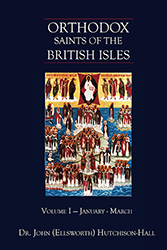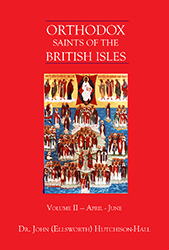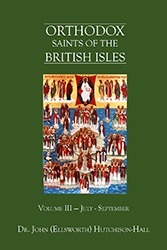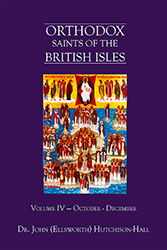
Orthodox Saints of the Pre-Schism
See of Rome
12th December (NS) — 29th November (OS) 2023
BLAISE and DEMETRIUS, (Date Unknown), martyrs at Veroli in Lazio, of whom no further information is extant.
BRENDAN of BIRR, founder of the Abbey of Birr in Offaly, which was the location of the Synod of Birr in 697, at which the Lex Innocentium, better known as Cáin Adomnáin (Law of Adomnán) was promulgated. The Abbey is also where the MacRegol or Rushworth Gospels, were produced c. 800.
St. Brendan began his monastic life as a disciple of St. Finian (12th December) at that great Irish nursery of saints of Clonard Abbey in present-day Co. Meath. At Clonard, St. Brendan was one of the group of students who went on to be known as the “Twelve Apostles of Ireland”, and is often known as St. Brendan the Elder to distinguish him from his better-known namesake and fellow student at Clonard St. Brendan the Voyager (16th May).
Despite being one of the lesser-known Apostles of Ireland, St. Brendan was an eminent church figure, as is evidenced by the epithet he was given of ‘Prophet of Ireland’. His eminence was further demonstrated by his defence of his close friend St. Columba (9th June) at the Synod of Meltown (in all likelihood c. 562), which prompted the synod to give St. Columba a sentence of exile, rather than excommunication over his role in the Battle of Cúl-drebene. Another consequence of St. Brendan’s long friendship and support for St. Columba was the development of close connexions between Birr and the various monasteries founded by St. Columba.
St. Brendan reposed circa 572, and at the moment of his repose St. Columba had a miraculous vision of St. Brendan’s soul carried by angels to Heaven.
Troparion of St. Brendan of Birr — Tone VIII
Most glorious ascetic and chief of Ireland's
Prophets, O Father Brendan, thou a bright beacon in the western isle guiding many to
salvation. At thy heavenly birthday the Angels rejoiced and miraculously announced their joy
to our Father Columba. The prayers of the
righteous avail much for us sinners. Wherefore
O Saint, pray to God for us that He will find
us a place in the Mansions of the Blest.
EGELWINE (ETHELWINE, AYLWINE), (Seventh Century), a prince of the House of Wessex, St. Egelwine abandoned the world and lived in great holiness as an anchorite at Athelney, Somerset, England.
GULSTAN (GUSTAN, CONSTANS), a disciple of St. Felix of Rhuys (4th March) at the Abbey of St. Gildas of Rhuys (29th January) in Brittany. St. Gulstan reposed circa 1010.
HARDOIN, a Briton who travelled to Brittany where he lived as a hermit and later served as Bishop of St. Pol-de-Léon. One legend states St. Hardoin was transported from the British Isles to Brittany in a stone boat propelled by angels. St. Hardoin reposed circa 650.
ILLUMINATA, a maiden, and possibly a martyr, in Todi, Umbria. St Illuminata reposed in the early fourth century.
RADBOD, consecrated fifteenth Bishop of Utrecht 900, he was forced to spend his final years in exile after his diocese was invaded by Vikings. St. Radbod reposed at Deventer in present-day Holland 917.
Troparion of St. Sadwen — Tone VIII
The remoteness of the Welsh mountains was
thy desert, O Father Sadwen, where thou didst
serve God in fasting and humility.
May thy continual intercession avail
for us sinners that our souls may be saved.
SADWRN (SADWEN), (Sixth Century), brother of St. Illtyd (6th November) and disciple of St. Cadfan (1st November). As is the case with his brother, nothing known of St. Sadwrn’s life and without the existence of churches in Wales dedicated to him, his existence might have been completely overlooked.
SATURNINUS (SERNIN), sent to help revitalise Christianity in Gaul following the Decian Persecution (250 – 251). St. Saturninus worked mainly in Toulouse and environs, serving as the first Bishop of Toulouse. He was martyred (circa 257) by the area’s pagan priests for his refusal to worship idols. There are several legends which link him with evangelism in other parts of Gaul and the Iberian Peninsula however, these are not historically verifiable.
SATURNINUS and SISINIUS, though there are no reliable details extant, it is thought that St. Saturninus was a native of Carthage who served as a priest in Rome. There, he, and his deacon Sisinius, were arrested during the persecutions under Emperor Maximian. They were then either sentenced to hard labour and worked to death, or were tortured and beheaded circa 257, and then buried on the Via Saleria, Rome.
WALDERIC, under the patronage of King Louis the Pious, St. Walderic founded and served as first Abbot of a monastery at Murrhardt, Swabia. St. Walderic reposed circa 817.
ABRA, little is known of St. Abra’s life. She was the daughter of St. Hilary of Poitiers (13th January), and devoted her short life to good works amongst her fellow Christians in Poitiers. St. Abra reposed, apparently of natural causes, at the age of eighteen in 360.
AGATHA, a nun, and disciple of St. Lioba (28th September) at Wimborne Abbey, both of whom joined St. Boniface (5th June) in his mission to the Germans. St. Agatha reposed c. 790.
COLMAN of GLENDALOUGH, an Abbot of Glendalough Monastery in Glendalough, Co. Wicklow, Ireland. He reposed in 659, and aside from being listed in the various Irish Kalendars nothing further is known of his life.
COLUMBA, this St. Columba was a native of Leinster, Ireland who after receiving monastic tonsure became a disciple of St. Finnian of Clonard (vide infra). He later served as Abbot of Tyrdaglas in Munster, Ireland. St. Columba was known for his great sanctity, and when St. Finnian was dying, it was St. Columba who is said to have given him the Viaticum. St. Columba reposed 548 at Tyrdaglas.
CORENTINUS (CURY), a hermit at Plomodiern in Brittany who is said to have been consecrated first Bishop of Cornouaille (present-day Quimper France) by Saint Martin of Tours (11th November). St. Corentinus reposed circa 490.
CORMAC, little is known of the life of St. Cormac, beyond his listing on various calendars on this date, as a sixth century abbot of great holiness. According to some sources he was a friend of St. Columba of Iona (9th June). The calendar of the Moscow Patriarchate lists a St. Cormac of the Sea who reposed 590, and whose feast is kept on 21st June.
Magister Sanctorum Hiberniae Sui Temporis
FINNIAN (VENNIANUS) of CLONARD, an early sixth century Irish abbot, founder of churches and monasteries, teacher, and wonder-worker. The twelve Apostles of Ireland were amongst his disciples, and St. Finnian is considered one of the fathers of Irish monasticism.
Little is known about his early life, which has led to him being confused with St. Finnian of Moville (10th September) at times, and there have been those who have even argued that he is merely a local manifestation of the Ulster saint. However, various Irish annals and genealogies clearly differentiate between the two.
St. Finnian went to Wales and became a disciple of SS. David (1st March), Gildas (29th January), and Cadoc (24th January). It should be noted that one or two sources assert he may have spent time at the monastery of St. Martin in Tours before going to Wales, though the majority opinion does not concur. No one is certain how long St. Finnian stayed in Wales. What is known is once he returned to Ireland, St. Finnian set about preaching and founding churches. He first founded the monastery at Aghowle, Co. Wicklow, and aside from Clonard, his most notable foundation was the church cum monastery at Skellig Michael (12 km / 8 mi off the coast of Co. Kerry). However, his most important contribution to the Church in Ireland was Clonard monastery, where at least three thousand clerics, abbots, bishops, and laymen from all over the British Isles, and Europe took advantage of both its sanctity as well as outstanding scholarship. St. Finnian and Clonard’s greatest claim to fame was training those great saints who went on to found important monasteries of their own.
St. Finnian reposed on 12th December, most likely a victim of plague. At the end, he is said to have been attended by his former pupil St. Columba of Tyrdaglas (vide supra) who gave him the Viaticum. The year of his repose has been the subject of some debate, the Four Masters list his repose as taking place in 548, though the Chronicon Scotorum lists him as one of the victims of the plague of 551. St. Finnian is the patron saint of Roman Catholic Diocese of Meath, of which some believe he was an early bishop. However, the Annals of the Four Masters, Martyrology of Donegal, as well as other Irish calendars all list him as only an abbot.
Troparion of St. Finnian of Clonard
Tone II
As one who laboured with zeal in the vineyard of God,
by ascetic struggles and toils thou didst ascend
from glory to glory, O God-bearing saint.
Wherefore, joining chorus now with all the venerable on high,
thou standest with boldness before the throne of the King of all,
Whom do thou beseech, O Finnian most wise,
that He have mercy and save our souls.
Kontakion of St. Finnian of Clonard
Tone VIII
Imitating the desert-dwellers of old, forsaking all the allurements of this world,
O venerable one, thou didst found houses for monastics throughout the Irish land,
filling its hills and vales with a host of noetic warriors who,
trained by thee, cut down the evil serpent with the sword of patience
and put his vile minions to flight through prayer.
Wherefore, we cry out to thee: Rejoice, O Finnian our father,
radiant beacon of the grace of God!
GREGORY of TERRACINA, a spiritual child of St. Benedict of Nursia (11th July) from whom he, and his brother St. Speciosus (15th March), received monastic tonsure. St. Gregory, later living at a monastery at Terracina, 55 km (35 mi) south-east of Rome. St. Gregory reposed circa 570.
MAXENTIUS, CONSTANTIUS, CRESCENTIUS, JUSTIN, and COMPANIONS, martyrs in Trier (circa 287), during the Diocletianic Persecution (303–313).
SYNESIUS, a young reader in Rome who, in 275, was martyred by beheading for preaching the Christian faith during the reign of the Emperor Aurelian (r. 270–275).
Prior to the Schism the Patriarchate of Rome was Orthodox, and fully in communion with the Orthodox Church. As Saint John of Shanghai and San Francisco +1966 said “The West was Orthodox for a thousand years, and her venerable Liturgy is far older than any of her heresies”.
Details of British Saints excerpted from Orthodox Saints of the British Isles.
Details of continental saints from these sources.
In many cases there are several spelling versions of the names of saints from the British Isles. I use the Oxford Dictionary of National Biography version as the primary version with the more prevalent version in parenthesis e.g. Ceadda (Chad) of Lichfield.





